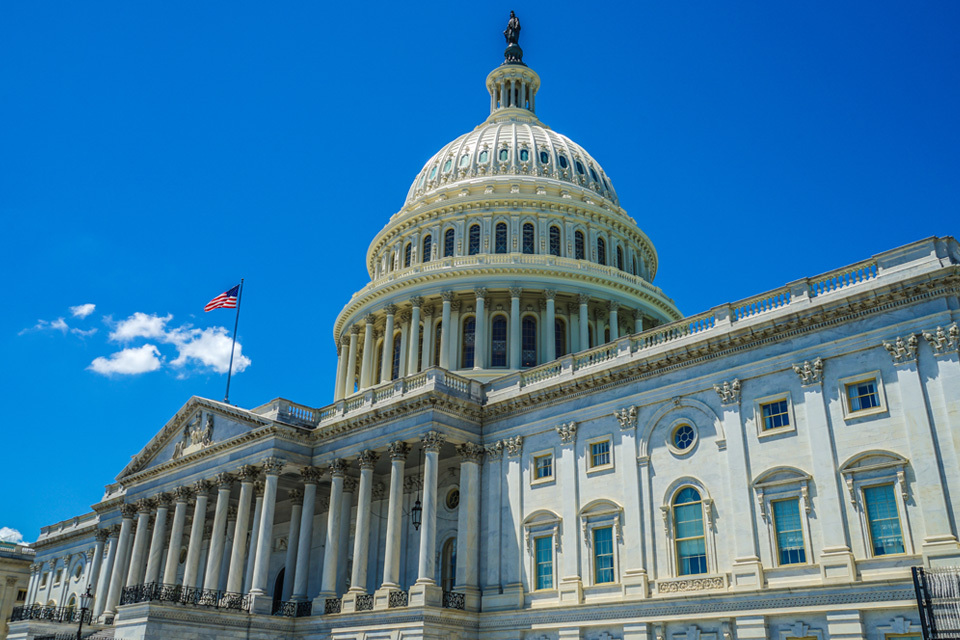Executive Summary Published May 26, 2023 · 7 minute read
Retaking the Podium: US National Security Hinges on Surpassing Russia and China in Nuclear Energy
Josh Freed, Alan Ahn, Ryan Norman, & Rowen Price

Ensuring Long-term US National Security Through Global Leadership in Advanced Reactors and Civil Nuclear Industry.
The export of civilian nuclear power plants creates 100 year relationships between the host and supplier countries. The Chinese and Russian governments recognize this and fully back their state-owned nuclear companies in winning export deals to expand their geopolitical influence. Every deal they secure risks undermining the United States’ security and diplomatic interests, as well as its ability to set the highest global standards for safety, security, and nonproliferation. In a period of surging international interest in nuclear energy for climate and energy security reasons, it is a vital national security imperative to make advanced nuclear technology commercially viable as soon as possible. The Department of Energy’s Pathways to Commercial Liftoff report for advanced nuclear clear on two critical points: 1) commercial viability comes after the 5th plant; and 2) meeting this threshold by 2035 requires aggressive USG support for new technology deployment.
This memo has been prepared as part of a broader framework to ensure US long-term national security by capturing the global market for advanced reactors and outcompeting Russian and Chinese industry. The following recommendations reflect near-term priority areas within the framework necessary to accelerate the development of versatile advanced nuclear technology to support US national interests in defense, diplomacy, and economic prosperity. Additional options are available to enable more ambitious changes to secure the US mid-to-long term competitive edge.
Fuel Cycle Development
Enact the Nuclear Fuel Security Act (S.452, H.R.1086). Provide DOE with additional tools for developing a commercial supply of LEU and HALEU as well as create an important market signal for nuclear fuel supply chain companies to make the investments required to build out such a capacity.
Provide appropriations to expand domestic uranium production capacity for HALEU and LEU through direct appropriations or the use of the Defense Production Act (DPA). Funding should be directly appropriated for this effort, which should remain available at the discretion of the Secretary of Energy, until fully utilized. To secure fuel supply for our fleet, reduce dependence on Russia, compete internationally, and disincentivize the spread of sensitive fuel cycle technologies, this is an absolutely essential national security priority.
Direct the Secretary of Energy to designate up to four DOE-owned or managed brownfield sites as national critical infrastructure sites. Through this new designation, the Secretary would be authorized to waive NEPA compliance for projects on these sites. Each critical infrastructure site should receive expedited review by the NRC for an early site permit and/or license application. In addition, NRC fee costs associated with permitting and licensing activities for national critical infractures sites would be waived.
Financing for Domestic Deployments
Provide required funding for the DOE Advanced Reactor Demonstration Program projects. DOE is already working with multiple advanced reactor companies to develop and deploy new technologies by the end of the decade. These projects are being deployed at new locations, including a retiring coal facility and to provide industrial heat to decarbonize an industrial facility. These innovative projects need to be fully funded to allow for efficient project management and support new applications of nuclear energy.
Provide funding for the Utah Associated Municipal Power Systems (UAMPS) Small Modular Reactor Demonstration. DOE has an existing award with UAMPS to commercialize the first NuScale VOYGR reactor in Idaho. Forward funding of this program would provide certainty to UAMPS to allow for efficient project management and avoid delays as well as support international interest in this technology.
Establish a DOE credit program to offer cost overrun protection to regional consortiums of multiple developers aligned on deploying a single technology. The consortium approach would allow for risk sharing among utilities and independent power producers in a given region, provided that each applicant agrees to select the same technology for deployment, thereby reducing technology risks. Upon successful completion of project milestones, similar to the NASA COTS program, DOE could provide credits to cover additional project costs incurred by the consortium.
Financing for International Deployments
Enhance the capabilities of the Export-Import Bank (EXIM) on civil nuclear projects. EXIM can more effectively support nuclear energy exports using existing programs and authorities with the following changes:
- Leverage the China and Transformational Exports Program (CTEP). CTEP, which enables EXIM to offer terms and conditions fully competitive with those of China and other covered countries, can be a powerful tool for nuclear exports by: (1) explicitly including nuclear energy in the list of Transformational Export Areas (or otherwise making CTEP technology-neutral), and (2) encouraging Treasury to execute its authority to also designate Russia as a “covered country.”
- Address the 2% default rate trigger. Whether exempting nuclear exports or CTEP-covered exports from the default rate, this is a vital step towards encouraging EXIM to support large, capital-intensive nuclear projects.
Strengthen the capacity of other agencies to support nuclear projects and enhance interagency coordination on nuclear exports. To complement debt financing from EXIM, other financing support will be crucial: equity financing, feasibility studies, pre-FEED work, capacity building programs, etc. Strengthening interagency coordination will be critical to rallying this suite of federal tools into comprehensive export financing packages.
- Enact the International Nuclear Energy Act, or INEA (S.826, H.R.2938). This encourages the establishment of a civil nuclear office in the White House and the development of a cohesive federal strategy on exports, among other impactful provisions.
- Authorize and fund other agencies to support nuclear exports. Other agencies (DFC, USTDA, State, NRC) require expanded authorities and/or capacities to conduct feasibility and FEED studies, pre-project phase work, training and development, licensing harmonization, etc. Enabling DFC to provide equity investments—a major advantage for our international competitors—by amending equity scoring rules will be pivotal.
Licensing and Regulatory Activities
Modify the agency’s mission. To include nuclear energy’s role in contributing to national security, the general welfare of society, and the efficient licensing and regulation of civilian nuclear industry.
Direct the NRC to develop a more expedient review process to issue licenses. For first-of-a-kind designs, this target should be less than 24 months. For subsequent deployments that are similar to a currently built and operating design, a final agency decision should be made within 12 months. If additional time beyond this schedule is required, the NRC would have to provide a notice and justification of the schedule extension to Congress.
Establish caps on pre-application and docketed application user fees. User fees for licensing reviews should be capped to instill confidence among new developers and reduce the fee burden on innovators. Increased predictability of fees would improve capital access for advanced reactor companies and promote investment in new technology. The NRC could be granted authority to waive the cap under certain circumstances, aligned with current authorities for annual fees.
Eliminate AEA requirement of uncontested mandatory hearings. NRC hearings can potentially increase timelines for every licensing action by 4-7 months without providing any additional safety benefits. These delays significantly impact financing timelines and increase the cost of projects.
Modernize the scope and role of the Advisory Committee on Reactor Safeguards (ACRS). Provide an efficient timeline for application reviews by removing the requirement to refer every license application to ACRS. The Commission should refer applications to the ACRS as necessary, in whole or in part, with direction to prioritize matters related to safety or unique reactor designs.
Authorize the use of streamlined environmental documentation. In particular, the expanded use of Environmental Assessments and Categorical Exclusions rather than Environmental Impact Statements.
Read: Framework for US Global Leadership in Advanced Reactors and Civil Nuclear Industry.



